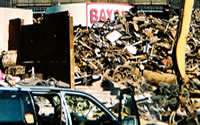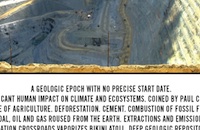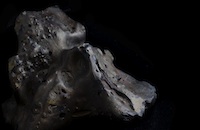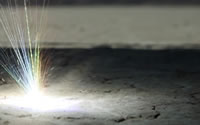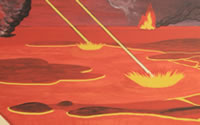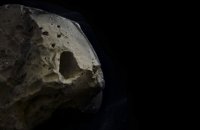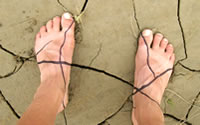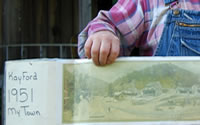4: Ediacaran and Anthropocene: Poetry as a Reader of Deep Time[1]
Don McKay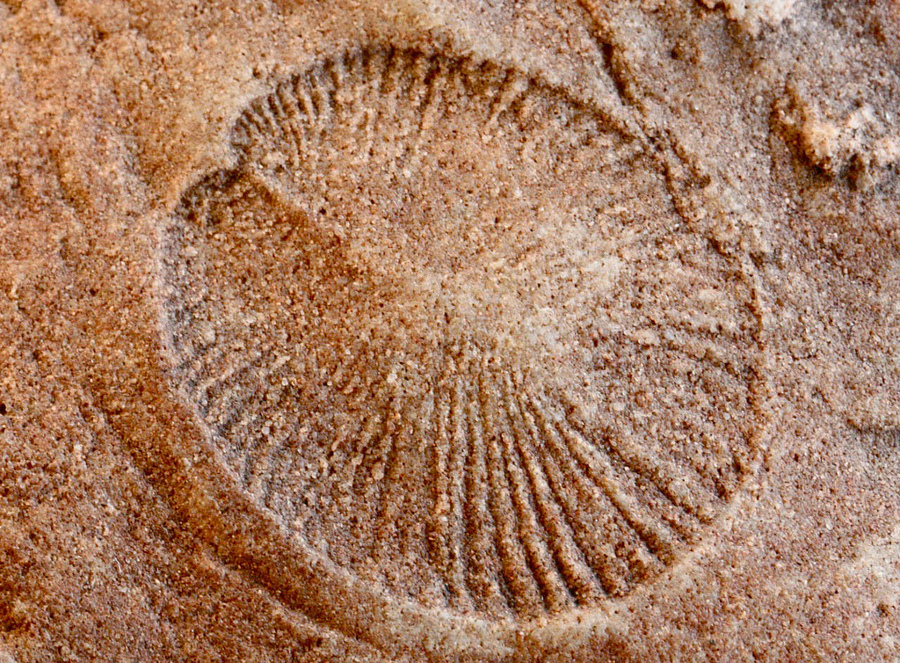
Two new developments in the taxonomy of temporality provide the focus for this discussion. One is the official recognition of a new, and very old, geologic period, the Ediacaran, now understood to occupy the stretch of deep time between 575 and 542 million years ago, directly preceding the Cambrian, with its remarkable radiation of life forms. This recognition is precipitated by the discovery, dating, and analysis of thirty or so species representing an entirely new biota in the fossil record, the earliest animals on the planet. The other wrinkle in our idea of time involves the proposal to name, or re-name, the current epoch after the species that has been most responsible for its character and style, as well as the content of most of its narratives. “The Anthropocene,” if accepted, would acknowledge ourselves as the superstars we have been for some time.
After its artful colon, the title divulges the unusual approach that I propose to take. My inspiration for this notion -- reading elements in deep time poetically -- comes from an unlikely source. It is in fact a geologist, Harry Hess, who coins the handy term “geopoetry,” a term that will certainly serve to identify the path I’m attempting to follow here. Hess was one of the researchers whose work led to the breakthrough understanding of plate tectonics, the crucial concept of a dynamic planet that revolutionized earth sciences in the 1960s. He described his speculations as geopoetry in order to induce his readers (mostly other geologists) to suspend their disbelief long enough for his observations about seafloor spreading, driven by magma rising continuously from the mantle, to catch on. He needed his audience, in the absence of much hard data, to speculate imaginatively, as if reading poetry. Now that so much evidence is in, and no one disbelieves in plate tectonics any more (at least no one who does not also disbelieve in evolution), the term might be allowed to lapse, a marriage of convenience whose raison d’être has evaporated. But, as you can see, I don’t think it ought to be. I think that Harry Hess, like Charles Darwin, Albert Einstein, or any other creative scientist, enters a mental space beyond ordinary analysis, where conjecture and imaginative play are needed and legitimate, and that this is a mental space shared with poets. But even more than this poetic license, I would say, the practice of geopoetry promotes astonishment as part of the acceptable perceptual frame. Geopoetry makes it legitimate for the natural historian or scientist to speculate and gawk, and equally legitimate for the poet to benefit from close observation, and from some of the amazing facts that science turns up. It provides a crossing point, a bridge over the infamous gulf separating scientific from poetic frames of mind, a gulf which has not served us well, nor the planet we inhabit with so little reverence or grace. Geopoetry, I am tempted to say, is the place where materialism and mysticism, those ancient enemies, finally come together, have a conversation in which each hearkens to the other, then go out for a drink. This may not lead to marriage or even cohabitation, but I’m guessing it does lead to a series of dates, trysts, rendezvous, and other encounters whose mood is erotic rather than simply disputatious.
First, the Ediacaran period. The first new period to be introduced to the geologic time scale in 120 years, it is, as Dr. Guy Narbonne has said, equal in importance to the discovery of a new planet in the solar system. The International Union of Geological Sciences has taken this measure because the fossils from the period, pre-dating those of the Burgess Shale, open an entirely unread chapter in the history of life. Ediacaran sites are rare, since these animals (or, some suggest, these members of an entirely new kingdom as yet unknown to taxonomy) were soft-bodied creatures without the shells and hard body armour, which make arthropods like trilobites common in the fossil record. As is usual in the naming of geologic periods, the name derives from a site where the index fossils or strata are found. So the Jurassic period derives its name from the Jura region in Switzerland, the Permian from the city of Perm in Russia, the Cambrian from Cambria, or Wales. Ediacara is in Southern Australia, where these fossils were first discovered, but some of the world’s best examples are at Mistaken Point, on the southern tip of the Avalon Peninsula in Newfoundland. In fact there are a few examples of the species known as Aspidella terranovica in downtown St. John’s on an outcrop kitty-corner from Tim Hortons. As an aside, I wish to observe, as a would-be geopoet, that it is too bad the Mistaken Point fossils were not discovered, or recognized for what they were, before those in Australia, since it would be a splendid moment in the annals of taxonomies to have a period called the Mistaken Pointarean. The name would carry an implicit awareness of its own instability, a fine thing in a name, if you ask me. Mistaken Pointarean would also be appropriate, perhaps, because these creatures seem to have survived a mere 50 million years, an eye-blink in deep time, and only something like 49 and three quarters million years longer than our own distinguished genus. I intend to circulate a petition asking the International Union of Geological Sciences to make this change in the interests of poeticizing the nomenclature. At the very least, the tourist board of Newfoundland and Labrador should support the move, aiming to reap some of the tourist dollars no doubt enjoyed by the likes of Jura and Perm.
If you were to travel as a geopoet-in-training to Mistaken Point to see these remarkable fossils, you would also see the beautiful barrens of the South Avalon on your hike into the site. These barrens -- themselves a candidate for renaming by poetry -- are only bare if your idea of flora excludes everything under four feet high. The carpet of vegetation over these windswept heaths is an interwoven mat of crowberry, partridgeberry, cranberry, juniper, sheep laurel, bottlebrush and Labrador Tea, with sporadic groves of tuckamore dotted here and there. Horned Larks and Water Pipits materialize out of this carpet, lift over a rise and disappear, an occasional Merlin hunts from the four-foot pinnacle of a stunted fir. Everything knows how to be low, how to hug the rock and hunch against the wind. By the time you get to Mistaken Point, you will have already grown accustomed to looking down and looking closely, especially if it happens to be foggy, which is likely. You will also, probably, have had enough experience being buffeted by wind to appreciate the ecosystem’s preference for a horizontal lifestyle.
The fossils are printed (although ‘embossed’ would be the more appropriate equivalent to the geologists’ ‘epirelief’) on flat tilted beds of sedimentary rock right next to the sea. Some of them resemble ostrich feathers, some resemble elongated spindles, and some Bradgatia —are bushy. One of the Ediacarans, an unusually long frond called Charnia wardi, has been named after the Ward family from nearby Portugal Cove South. It was Catherine Ward and her son Brad who, having spotted two Americans trying to steal specimens from the fossil beds using a diamond saw, blockaded the road and called the RCMP. And it was Brad (who is now a geophysicist) who found the best example of the species that now carries the family name. Charnia wardi has since proven to be the oldest complex organism (that is, multiply-celled) in the fossil record, and the tallest of the Ediacarans.
Like all fossils, the Ediacarans are, in Christopher Dewdney’s phrase, “pure memory,” and seem to call, life form to life form, across 575 million years of evolution and geological transformation. It’s as though the usually mute siltstone were sending semiotic signals. These animals (or ‘animals’) were soft-bodied stalks, connected to the ocean floor by hold-fasts, like kelp, living a life perhaps similar to today’s jellyfish. It has been speculated by some scientists that they may have existed in a symbiotic relationship with primitive plants, perhaps as a plant-animal hybrid. They preyed on no other creature and, it seems, were not preyed upon themselves. Because of this, the period has been nicknamed The Garden of Ediacara by Mark McMenamin, apparently existing before predation, when symbiosis rather than predation was the order of the day. And, it also seems, they perished abruptly after 50 million years, when some creatures developed the canny notion, which has held sway ever since, that a quick way to nourish yourself is to eat somebody else. That, for the Garden of Ediacara, would have been the equivalent to the Fall. Enter the era of claws and shells.
Listening in on such geopoetry as, in the spirit of Harry Hess, I venture to call it, one feels one’s thinking stretch as it takes on these remote possibilities. That stretch is, I think, not only epistemological (having to do with knowing) but ontological; it involves wonder at the manifold possibilities of being in general, and these beings in particular. Within a purely rational or analytical context such theories crave closure, desire to resolve into fact. The poetic frame permits the possible (I’m thinking of the sense in which Richard Kearney develops the concept) to be experienced as a power rather than a deficiency; it permits the imagination entry, finding wider resonances, leading us to contemplate further implications for ourselves. For although we are palpably here, our presence is no less a remote possibility in the long accident-riddled course of evolution than is that of the Charnia wardi and other Ediacarans embossed on the rock.
Today, at Mistaken Point, you can caress the rock with your finger and read their unreadable lines like Braille. You can trace the line between the fossil-bearing siltstone and the petrified volcanic ash that, ironically enough, both killed and preserved them, their assassin and archivist. These particular creatures were living off the coast of Gondwana when the volcano erupted, sending a cloud of ash high into the air, to be carried over the ocean. (Think of the extent of the fallout from Mount St. Helen’s.) Eventually the ash particles settled into the water, smothering the Ediacarans under a soft grey cushion. Here and there in the ash layer (now a thin gritty black film) you can see bits of pink feldspar that crystallized out of the magma in the original eruption. You might have the sense, as I have had, that the fossils have been unveiled, as though some intentional hand were eroding the ash to reveal the beautiful fronds and disks beneath. Heidegger’s term for beauty, unconcealment or aletheia, seems almost literally enacted by geologic forces. It even seems as though the slab on which they appear had been pulled from the other strata on the adjacent cliff like a drawer pulled open in a morgue for the corpse to be identified—an image that no doubt springs to mind due to my unhealthy predilection for cop shows, where it is a mandatory scene. If you’re lucky, very lucky, it’s sunny, and it’s evening, so the slant light emphasizes the slight rise of the figures from the rock (their epirelief) and calls them to special eloquence, along with the deep nostalgia that dusk always lends its subjects. Pure memory. It is 570 million years ago on the other side of the Iapetus Ocean, an ocean that by the end of the Palaeozoic will have closed like a slow gigantic wink, along the continental shelf of Gondwana, the parent continent of both Africa and the Avalon Peninsula. Slim creatures sway at different heights in the tide, giving and taking from the water, existing in a world without predators. It is also, say, a Tuesday in September on the southern tip of the Avalon; the sun is setting; you’d better get going if you want to reach your car before dark.
In a geopoetic experience, like the imagined field trip to Mistaken Point, both elements, the ‘geo’ and the poetic, give something, and both, I think, inhibit or counteract a tendency in their partner. I am thinking here, as may be obvious, of a simpler version of the complex inter-relations between members of a symbiosis. Geology, or broadly speaking natural history of any kind, brings the rigour of the scientific frame; poetry brings the capacity for astonishment and the power of possibility, or, perhaps more accurately, legitimizes them. Geology inhibits the tendency, most common in romantic poets, to translate the immediate perception into an emotional condition, which is then admired or fetishized in preference to the original phenomenon—fossil, bird, lichen or landform. For its part, poetry cultivates the astonishment that naturally occurs in the presence of such marvels. As Adam Zagajewski says, poetry allows us “to experience astonishment and to stop in that astonishment for a long moment or two.” By doing so it counteracts the tendency, perhaps most common in scientists in the grip of triumphalist technology, to reduce objects of contemplation to quanta of knowledge. Astonishment, humbling our pride in technique, impedes its progress into exploitation and appropriation. In the astonished condition, the other remains other, wilderness remains wild. Robert Hass, in Time and Materials, makes a cogent observation, which speaks to Zagajewski’s idea of poetry. Interestingly, for the would-be geopoets among us, Hass writes these lines in response to an old lava field:
It must be a gift of evolution that humans
Can’t sustain wonder. We’d never have gotten up
From our knees if we could.
Hass makes a good point here, fine, contemplative nature poet that he is. If we could sustain wonder, we’d probably all have been devoured by sabre-toothed tigers long before homo erectus could evolve into homo sapiens; we’d be gawking at the marvel of the hairy mammoths and neglect entirely to slip our clever clovis-pointed spears between their massive ribs.
Nevertheless, speaking as a human existing in the outflow of the scientific revolution, living in a period of technological mania, I can’t help but feel that we would have benefitted from spending more time on our knees, rapt, attending to the being of the other rather than classifying, analyzing, controlling, exploiting, and generally rendering the world as standing reserve available for our use. This is one of the ways in which poetry—any poetry—is always political and subversive: it uses our foremost technological tool, the ur-tool that is language, against itself, against its tendency to be the supreme analytic and organizing instrument. In poetry, language is always a singer as well as a thinker; a lover as well as an engineer. It discovers and delights in its own physical being, as though it were an otter or a raven rather than simply the vice president in charge of making sense.
Well, perhaps my characterization of the geological and poetic elements as symbionts is more of a hope than an observation, a self-serving attempt on my own part to integrate diverse bits of my cluttered life. But it does seem worthwhile to entertain the possibility that the two elements may, at least in isolated instances, feed, and feed upon, one another, and not just inhibit their respective excesses. When the intense experience of poetry, that momentary lyric peak, diminishes, we can turn to a more empirical attitude with a trace or memory of it persisting in our approach. The afterlife of wonder might well persist as a spirit animating the frame of knowledge. And likewise, the thirst to know, which has since Aristotle been recognized as fundamental to human sensibility, might be understood as an accelerant to poetic attention, rather than—as is usual—an aesthetic turn-off. The impact of the Ediacaran fossils is not diminished by a recognition of their place in the evolution of early life of the planet. In fact, I venture to think that such scientific reflections may serve to extend the condition of wonder from its peak epiphany into everyday existence. We might find it spreading from exceptional instances, like a trip to Mistaken Point, to the nondescript rock in my back yard, which turns out to have travelled here from its birthplace in a volcano on the continent that became today’s Africa.
This brings us, with more of a lurch than a glide, to the second time period named in the title, the Anthropocene Epoch. The Anthropocene has been proposed, though not yet officially recognized by the International Union of Geological Sciences, as the name for the epoch in which we are now living, an epoch characterized by the profound effect on the earth’s systems of one species: anthropos, us. If generally accepted it would succeed the Holocene, the epoch that has extended from the ice ages (the Pleistocene) to the present. The date proposed for its onset differs from thinker to thinker, some placing it at the industrial revolution, others spotting the writing on the wall as early as the discoveries of agriculture or fire. Whatever the starting point, it is judged that the innovative technologies of anthropos, leveling forests, making cities, producing networks of roads, eliminating some species and domesticating others, have altered the workings of the planet’s cycles in a way analogous to an ice age or a collision with an asteroid. Most tellingly, we’ve been digging up fossilized organisms and burning them, effectively turning earthbound carbon into atmospheric carbon, drastically altering the climate, as has occurred at other times in the earth’s history when a greenhouse effect has come about from other causes. As Dean Young (not someone you might think of as an environmental poet) puts it, “Somehow/ we’ve managed to ruin the sky/ just by going about our business,/ I in my super XL, you in your Discoverer.” Writing, prophetically, in 1973, Christopher Dewdney observed that the effect of all the highways and associated fossil fuel emissions would be a kind of renaissance for the old Mesozoic atmosphere in which the plants originally grew.
The philosopher Emmanuel Levinas has given us a definition of European culture that resonates, in a sinister way, with the naming of the new epoch. “Culture,” he says, “can be interpreted as an intention to remove the otherness of Nature, which, alien and previous, surprises and strikes the immediate identity which is the same of the human self.” As an intention that converts the otherness of nature into the sameness of humanity, Levinas’ culture sounds alarmingly like Calgary, eating its way steadily toward the Rockies, converting foothills into dismal suburbs of itself. It is against such reduction to the Same that poetry works, introducing otherness, or wilderness, into consciousness without insisting that it be turned wholly into knowledge, into what we know, what we own. Within poetic attention, we might say, what we behold is always “alien and previous,” whether it’s an exceptional fossil or an “ordinary” rock or chickadee. In poetry there is no “been there, done that;” everything is wilderness. The arrival of the Anthropocene would be an acknowledgement that the intention of culture, as Levinas sees it, has been all too richly realized, that there is little hope for an other that remains other, for wilderness that remains wild. It implicitly acknowledges that there will be no epoch called the Gaiacene, even though the concept was developed and maintained during the last century. In fact, the author of the concept, James Lovelock, is among the least optimistic of the earth scientists contemplating climate change.
Now, there actually is a way that culture has addressed nature during the last two centuries that is not exploitive or consumptive, at least on the surface, and that is Romanticism. Surely this must be reckoned a good thing, since it does not lead, like technology, to a reduction of the natural to either raw material or product. This is true. But Romanticism (of course, I am indulging in a lavish generalization) preserves the other not by respecting its otherness, but by welcoming it into the Same as a form of humanism. Nature as the kindly, pedagogical nurse in Wordsworth’s poetry leads us to hear, not some “alien and previous” harmonies but the “still, sad music of humanity.” No less than the technological mindset, Romanticism converts the other into the Same of the human self, but by a soft and seductive path, the generous extension of citizenship rather than violent reduction to utility. One thinks of certain Americans who praise our national character by announcing, generously, that it is the same as theirs.
I was struck afresh, recently, by the famous stolen boat passage from Wordsworth’s The Prelude. You probably recall it, but let me summon it to mind in some detail, since it raises, quite insightfully, I think, the issue of wilderness, or the unassimilable otherness of the other. As he remembers it, Wordsworth “borrowed” a boat one evening and rowed out on Lake Windermere, getting far enough from shore that the perspective altered and a distant peak, occluded when closer in, suddenly loomed:
. . . The huge cliff
Rose up between me and the stars, and still
With measur’d motion, like a living thing
Strode after me.
Panicked, he beat a hasty retreat back to shore and, in the days following, was deeply troubled, for it was not the usual contact with Nature, which, as mentor and pedagogue, guided his development in humanistic ways. He had suddenly experienced wilderness-as-other, remorseless and terrifying. Of course, there is always a touch of terror in the experience of the sublime, but the young Wordsworth had received an overdose, and it would leave him at a loss to bring it into harmony with his earlier understanding of Nature:
. . . and after I had seen
That spectacle, for many days, my brain
Worked with a dim and undetermin’d sense
Of unknown modes of being; in my thoughts
There was a darkness, call it solitude
Or blank desertion, no familiar shapes
Of hourly objects, images of trees
Of sea or sky, no colours of green fields;
But huge and mighty forms that do not live
Like living men mov’d slowly through my mind
By day and were the trouble of my dreams.
In this wonderful passage, the scrim of humanism is torn aside, to be replaced by unknown modes of being, huge and mighty forms that do not live like living men. The experience has revealed the wilderness lurking, like the distant peak, behind and within the idea of Nature, not only resisting the domesticating power of mind (refusing to become the same of culture) but indeed going on the offensive—pursuing, watching, troubling his dreams. Recall Margaret Atwood’s query of the lady beholding the apparently innocent relief map of Canada: “Do you see nothing/ watching you from under the water?”
It is interesting to speculate, from a Canadian point of view, on what might have occurred to the young Wordsworth had he been unable to escape that wilderness experience, but been forced to live within it. What if he’d had to live with the “alien and previous” other rather than a Nature that endorsed human values? Well, I think Earle Birney provides the answer in his classic poem “Bushed,” a poem that identifies the psychosis we have come to recognize as the consequence of an overdose of wilderness overwhelming the European consciousness. It is notable not only as a cautionary tale for all crypto-Wordsworthians, and not only because of its toothed imagery and curt music, but also because it articulates a crucial ambiguity at the heart of this breakdown. Is Birney’s Romantic protagonist, having had his illusions about the sublime wrecked by the alien wilderness, about to become a nutcase or to enter the state of privileged consciousness that we would call, were we Native Americans rather than displaced Europeans, shamanistic? Birney doesn’t say:
then he knew though the mountain slept the winds
were shaping its peak to an arrowhead
poised
And now he could only
bar himself in and wait
for the great flint to come singing into his heart.
For geopoetry to work, then, it must avoid Romantic humanism, despite its considerable uplift and charm, and acknowledge the alien and previous character of the wilderness up front. The astonishment of poetry is right next door to being petrified—as the young Wordsworth and Birney’s protagonist discovered. Wilderness does not endorse us as humans; it includes us as mammals.
Entering the Anthropocene, it seems, places our gifted but difficult species in a spotlight. At one time, i.e. the Enlightenment, such a focus seemed the illumination that relieved an oppressive darkness, enabling humankind to know itself and exercise fully its intellectual capacities. Now that spotlight may be more analogous to the headlight in which the deer is caught. But despite the dire events and portents that led to it, news of which assaults us daily, I believe there is a positive side to the nomination of the Anthropocene. All poets take naming seriously, aware that such baptisms into language carry enormous potential power. Language is, as John Steffler observed in his recent E.J. Pratt lecture, the first technology that we, the technological animals, have developed; it is the technology upon which all others depend. Naming might be said to be its first move in the conversation of the “alien and previous” into the familiar, accessible and manipulable Same. But the naming of the Anthropocene differs from others in at least two ways. One is that it is partly a negative recognition. Usually, if you get something named after yourself, or you name an organism, like Charnia wardi, after its discoverers and stewards, it’s an honour. In the case of the Anthropocene, naming is an acknowledgement of responsibility and, in some measure, guilt. Although I do not rule out the possibility that there are folk out there cheering the advent of the epoch as a victory for our side, maybe even in some perverse way the material triumph of humanism, most will regard it as an act akin to naming atrocity atrocity or genocide genocide. Negative recognition, as with the familiar practice at A.A. meetings of identifying yourself as an alcoholic when you rise to speak, can become empowering. Among the recent works of Canadian poets in this vein, I would cite Dennis Lee’s remarkable books un and yesno, with their torqued contorted technospeak, as well as Pierre Nepveu’s Mirabel, which brings poetry to witness the replacement of a pastoral landscape with a useless airport.
The second thing I have to say about the naming of the Anthro-pocene, and the last item in this breccia of an essay, regards its function as an entry point into deep time. If we think of ourselves as living in the Anthropocene Epoch, we realign our notion of temporal dwelling. Generally, time is viewed in relation to humanity’s place in it, and consists of a present, where we live, and a recent past called history, which is felt to be important for informing the present and helping us understand ourselves better. When we speak of the past with reverence or chagrin, it is this shallow past we mean. Before history there is a vague distant past called prehistory, comprised of a jumble of relics and catastrophes, dinosaur bones mixed with clovis points, missing links, Lucy and The Flintstones cohabiting in the caves of Lascaux, Australopithecus confused with archaeopteryx, and the whole mélange construed as a sort of amniotic stew from which we, the Master Species, miraculously emerged. The name “Anthropocene,” paradoxically enough, puts a crimp in this anthropocentrism, making the present a temporal unit among other epochs, periods and eras. If we think backward from the Anthropocene we encounter, like rungs on a ladder, the Holocene, the Pleistocene, Pliocene and Miocene epochs, and by this point there are no humans around, or even representatives of the homo genus, and we realize that the ladder extends back through periods and eras to the Ediacaran, and that even at this point we’ve covered only half a billion of the planet’s four and a half billion years. On the one hand, we lose our special status as Master Species; on the other, we become members of deep time, along with trilobites and Ediacaran organisms. We gain the gift of de-familiarization, becoming other to ourselves, one expression of the ever-evolving planet. Inhabiting deep time imaginatively, we give up mastery and gain mutuality.
back to top ↑Notes
- Reprinted from Prairie Fire 29.4 (Winter 2008-2009): 4-15 [The Anne Szumigalski Memorial Lecture].↑
Selective Sources
- Atwood, Margaret. 1968. "At the Tourist Centre in Boston." In The Animals in That Country. Oxford: Oxford University Press.
- Birney, Earle. [1951] 1975. "Bushed." In The Collected Poems, Vol. 1 Toronto: McClelland & Stewart.
- Bjonerud, Marcia. 2006. Reading the Rocks: The Autobiography of the Earth. New York: Basic Books.
- Dewdney, Christopher. 1983. Predators of the Adoration: Selected Poems, 1972-1982. Toronto: McClelland & Stewart.
- Hass, Robert. 2007. Time and Materials: Poems 1997-2005. New York: Ecco, 2007.
- Levinas, Emmanuel. 2000. Entre Nous: Thinking-of-the-Other, trans. Michael B. Smith and Barbara Harshaw. New York: Columbia University Press.
- Stanley, Steven M. 2004. Earth System History. New York: W.H. Freeman.
- Wordsworth, William. 1805. The Prelude.
- Young, Dean. 2002. Skid. Pittsburgh: University of Pittsburgh Press.
- Zagajewski, Adam. 2002. Another Beauty. Athens: University of Georgia Press.
Thanks to the staff at the Interpretation Centre in Portugal Cove South, especially Richard Thomas and Julie Cappleman, to Paul Dean at the Johnson Geocentre, and to provincial palaeontologist Doug Boyce. All have been very helpful and informative. Such foolish errors and extrapolations as appear are my own doing.
